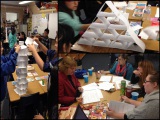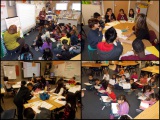-
Category 1
Selected in 2013
-
Grades: pre k - 6
School Setting: urban
Town Population: 92,000
Student Enrollment: 608
Student Demographics:
Black/African American: 4%
Teacher/Student Ratio: 1:22
White/Caucasian: 19%
Hispanic: 67%
Hawaiian/Pacific Islander: 1%
Asian: 1%
Native American: 4%
Other: 4%
% Reduced Lunch: 79.8%
% ELL Learners: 40%
Founded: 1958 -
PRINCIPAL:
Larry Kuper -
CONTACT:
2300 North Rock Blvd
Sparks, NV 89431
775-353-5580
lkuper@washoeschools.net
Alice Maxwell Elementary
Sparks, NV
Lively and in-depth discussions are common place as teachers debate, propose, and refine the lessons and instructional strategies to be used. These discussions not only facilitate the creation of highly effective lessons, but they deepen understanding of the content, the core standards, and the most effective strategies to deliver the content.
- What is the single most important factor in the success of your school that others could replicate?
-
Staff consistently identified common or shared planning as an important factor for student success. Lesson planning is done together as a grade level team. The Nevada Academic Core Standards are used to develop curriculum and lessons.
Lively and in-depth discussions are common place as teachers debate, propose, and refine the lessons and instructional strategies to be used. These discussions not only facilitate the creation of highly effective lessons, but they deepen understanding of the content, the core standards, and the most effective strategies to deliver the content.
The common planning helps assure that all students in the grade level receive the same high quality of instruction and content. There is little concern from parents or staff that the students in that grade level may have missed key concepts as they move through our school since all the students in that grade receive instruction based on the same plans.
- Describe the program or initiative that has had the greatest positive effect on student achievement, including closing achievement or opportunity gaps, if applicable.
- The decision to develop strong professional learning communities within grade level teams has been a significant factor on student achievement. It allowed teachers to grow together, get clear about learning outcomes, and to discuss student achievement in relation to their outcomes. To support these learning communities, PLC time was closely guarded from any other activity that might intrude into the set aside time.
- Explain how Title I funds are used to support your improvement efforts.
- Staffing, substitutes, and extra duty pay are prioritized in our budget. Approximately 50% of our Title I budget is used to provide support staff. This allows us to provide more direct support to students. Our aides and assistants are involved assisting and instructing students during the instructional day. Clerical tasks are completed before or after school. Approximately 10% goes to supporting professional development and professional learning communities. Teachers are either released from their classrooms or provided extra duty pay for classes or planning outside the contracted day. The remainder of the budget is allocated based on building goals and needs as determined each year.
- Identify the critical professional development activities you use to improve teaching and student learning.
- Our focus was on the Common Core Math Standards improved teaching which led to improved student learning. The professional development included studying the 8 mathematical practices and Mathematical Discourse. The trainings built on each other throughout the year and teachers were given feedback in relation to the expectations for implementation. Student success was measured in math and teachers continually reflected on their practices. Using district trainers and building staff this focus provided the core of professional development over the year.
- Describe how data is used to improve student achievement and inform decision making.
-
Assessment data is the driver for short term and long term planning. All of our assessments are aligned with the Nevada Academic Core Standards.
The DRA is used for all students in grades kindergarten through second grade The Measurement of Academic Progress is given three times over the year to students in grades two through six. At the state level, the Criterion Reference Test is given to all students in grades three through six. Grade level teams spend a day with the principal, assistant principal, counselor, and other support staff as available to review the scores for adequate growth and developing student, staff, and building goals.
Besides academic data, we gather feedback from parents, students, and staff with climate surveys to help develop school curriculum, professional development, and parent support. From classroom instruction to building wide goals, using school data is a vital component for increasing student achievement.
- Describe your school culture and explain changes you’ve taken to improve it.
-
Our culture developed around high expectations for all students, collaborative planning for high quality lessons, and commitment to using the best instructional practices to deliver content. Over the past two years, our actions have continued to solidify these expectations as our driving forces. We strive to create the highest quality tier one instruction possible. We believe every student can reach high standards with the support provided at our school.
Trust is a significant factor binding us together. We believe each staff member will hold himself or herself to our shared expectations and work with a focus on student achievement. We provide common planning time on early release days three times per month. Lesson plans are collected each week to monitor for consistency across the school. Grade level teams use a planning day each quarter to develop long term plans. It is expected that all students receive instruction as designed in the lesson plan.
Stats
-
Category 1
Selected in 2013
-
Grades: pre k - 6
School Setting: urban
Town Population: 92,000
Student Enrollment: 608
Student Demographics:
Black/African American: 4%
Teacher/Student Ratio: 1:22
White/Caucasian: 19%
Hispanic: 67%
Hawaiian/Pacific Islander: 1%
Asian: 1%
Native American: 4%
Other: 4%
% Reduced Lunch: 79.8%
% ELL Learners: 40%
Founded: 1958 -
PRINCIPAL:
Larry Kuper -
CONTACT:
2300 North Rock Blvd
Sparks, NV 89431
775-353-5580
lkuper@washoeschools.net









